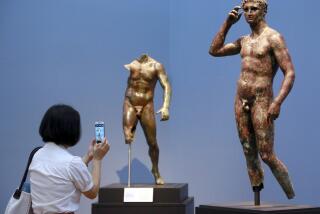Getty purchases Roman antiquity
- Share via
In a move signaling its return to collecting Mediterranean antiquities -- with tight restrictions -- the J. Paul Getty Museum has acquired a late 3rd century Roman sarcophagus that depicts a wine-making festival.
One of only six similarly decorated ancient funerary monuments known to exist, the elaborately carved marble work will go on display at the Getty Villa on June 12.
The sarcophagus -- which portrays a panorama of curly-haired cupids harvesting and stomping grapes, bordered by a pair of lion heads -- is the first major piece to be added to the antiquities collection since the Getty and other museums became embroiled in an international controversy about ancient artworks thought to have been illegally exported, said Karol Wight, the Getty’s senior curator of antiquities.
The recent purchase -- made at an undisclosed price from an unidentified private collection in London -- adheres to a Getty policy adopted in 2006 that requires each newly acquired antiquity to have a clear ownership history dating to 1970, when an international agreement prohibited traffic in looted art.
More to Read
The biggest entertainment stories
Get our big stories about Hollywood, film, television, music, arts, culture and more right in your inbox as soon as they publish.
You may occasionally receive promotional content from the Los Angeles Times.










